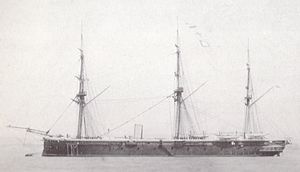- Defence class ironclad
-

Defence as she appeared after 1866Class overview Builders: Palmer Brothers, Jarrow
Westwood, Baillie, Cubitt TownPreceded by: Warrior class ironclad Built: 1859–1862 In commission: 1861–1935 Completed: 2 General characteristics Type: Ironclad battleships Displacement: Resistance: 6,070 tons
Defence: 6,150 tonsLength: 302 ft (92 m) o/a
280 ft (85 m) p/pBeam: 54 ft 2 in (16.51 m) Draught: 24 ft 6 in (7.47 m) forward
26 ft (7.9 m)aftInstalled power: 2,540 ihp (1,890 kW) Propulsion: Single-shaft Penn trunk engine Sail plan: Barque rig, sail area 24,500 sq ft (2,280 m2) Speed: 10.75 kn (19.91 km/h) under power
10.5 kn (19.4 km/h) under sailComplement: 460 Armament: 6 × 7 in (180 mm) Armstrong breech-loaders
14 × 7 in (180 mm) 6½ ton muzzle-loading rifles
10 × 68 pounder guns
2 × 32 pounders
After 1867 refit:
2 × 8 in (200 mm) muzzle-loading riflesArmour: 4.5 in (110 mm) with 18-inch (460 mm) teak backing
4.5 inch bulkheadsThe Defence class of ironclad battleships were the class which historically immediately followed the first two British ironclads, HMS Warrior and HMS Black Prince. The class consisted of two ships, HMS Defence and HMS Resistance.
Contents
Background
In 1859 the Admiralty was as yet not convinced that the cost of the HMS Warrior class, which had significantly exceeded the costs of all previous warships, had to be accepted as the norm. It had been noted that the armour plate of 4.5 inches (110 mm) thickness as fitted to these vessels was adequate to deflect all ordnance currently afloat, and Their Lordships therefore requested a class of ships which, while carrying the same armour as the Warriors, was cheaper and smaller.
Design
The designer, Isaac Watts, submitted a plan on November 24, 1859, in which he made it clear that he could only incorporate enough engine power for 10.75 knots (20 km/h), which would leave the French ironclad La Gloire some two knots faster, and able to avoid action if she so chose.
In view of the French programme of ironclad construction, which showed signs of overtaking the British, the Admiralty proposed that six ships of this design be constructed. Political considerations however ultimately ensured that only two were ordered on 14 December 1859. The Prime Minister of the day, Lord Palmerston, was not convinced that the day of the wooden line-of-battle ship had passed.
Sir Nathaniel Barnaby, a future Constructor of the Navy, considered that in terms of combat a Defence-class ship was worth one quarter of a Warrior.
Construction
Ship Builder Laid down Launched Commissioned Fate Cost Defence Palmers, Jarrow December 1859 24 April 1861 4 December 1861 Scrapped 1935 £252,422[1] Resistance Westwood, Baillie, Cubitt Town, London December 1859 11 April 1861 2 July 1862 Sold 1898, foundered under tow 1899 £258,120[1] Notes
References
- Ballard, G. A., Admiral (1980). The Black Battlefleet. Annapolis, MD: Naval Institute Press. ISBN 0-87021-924-3.
- Gardiner, Robert, ed (1979). Conway's All the World's Fighting Ships 1860-1905. Greenwich: Conway Maritime Press. ISBN 0-8317-0302-4.
- Parkes, Oscar (1990). British Battleships (reprint of the 1957 ed.). Annapolis, MD: Naval Institute Press. ISBN 1-55750-075-4.
- Silverstone, Paul H. (1984). Directory of the World's Capital Ships. New York: Hippocrene Books. ISBN 0-88254-979-0.
External links
Defence-class ironcladCategories:- Battleship classes
- Defence class battleships
- Victorian era battleships of the United Kingdom
Wikimedia Foundation. 2010.
